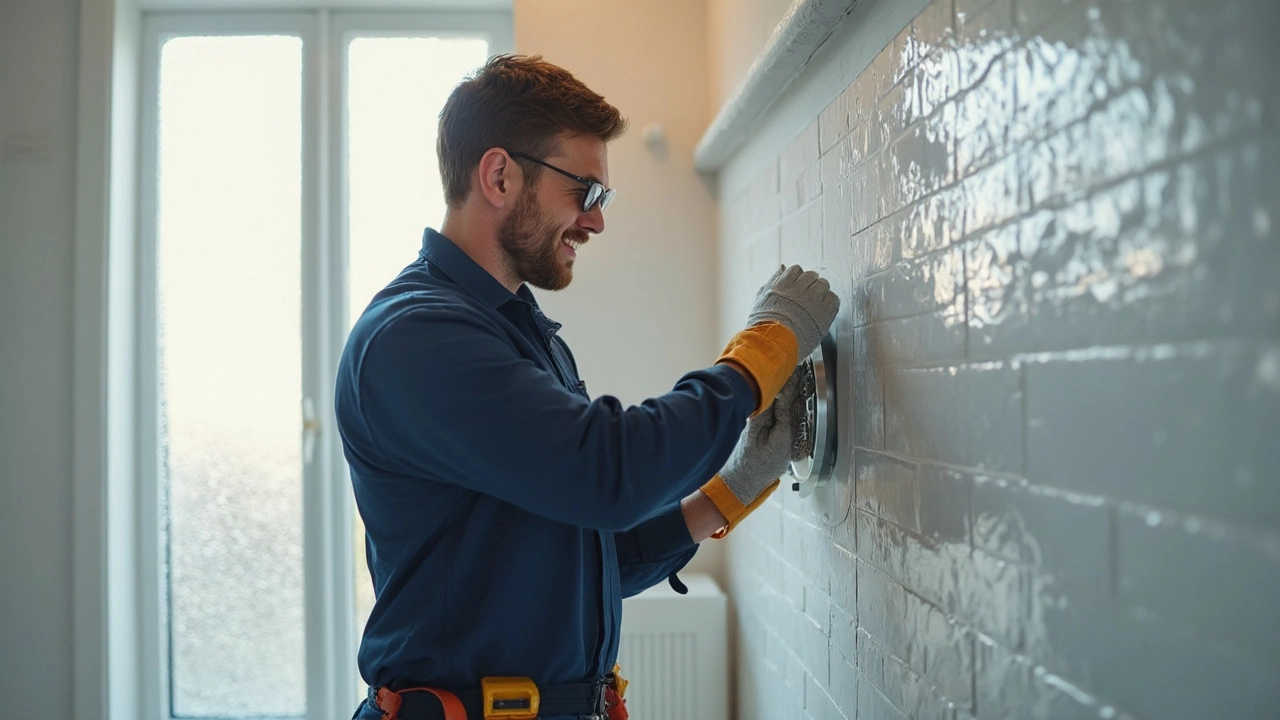Go to any busy kitchen at dinnertime and there’s a good chance you’ll hear that steady whirr overhead. Extractor fans have become something most people take for granted—until you notice foggy mirrors, persistent odors, or even mold creeping across your bathroom ceiling. When it’s time for a new extractor fan, or your old one breathes its last, the first question that pops up is: who’s the right person for the job? Can you just call your local handyman, or does it need a specialist? And what’s actually involved in fitting one of these noisy little lifesavers?
Who Is Qualified to Install an Extractor Fan?
Here’s the thing—fitting an extractor fan isn’t like hanging a shelf or changing a lightbulb. Sure, it looks straightforward, but you’re dealing with electricity, and sometimes, with making holes through your home’s walls or ceilings. This isn’t just about keeping steam off the windows; it’s a job with some real legal guidelines.
In the UK, installing an extractor fan in places like bathrooms and kitchens usually comes under ‘Part P’ of the building regulations. This means, by law, electrical work in wet rooms needs to meet certain safety standards. An average DIYer can legally swap out a like-for-like fan, but if you’re fitting a new one or messing with wiring, you’ll need a qualified electrician or a Part P registered competent person.
If you’re renting, landlords have an extra layer of responsibility. It’s their job to provide “adequate ventilation” according to The Housing Act 2004 and updates in 2022, so ignoring that mold patch by skipping the fan is a fast route to tenant complaints—and hefty fines.
So, who actually turns up to install the thing? Usually, these folks:
- Qualified electricians—Most common and safest option for anything involving new wiring.
- Builder or handyman—For fitting if the wiring's in place, or for purely mechanical swaps in non-special rooms.
- Ventilation specialists—These are the folks you want for big jobs, like ducting a new system across multiple rooms or running long vent lines in large homes or commercial spaces.
- Kitchen and bathroom fitters—If you’re getting a whole new kitchen or bathroom, these specialists often handle ventilation as part of a bigger package.
In reality, electricians do most of the heavy lifting when it comes to new extractor fan installations, especially in bathrooms. A decent electrician should give you a certificate—proof they did it right and to code.
What Types of Extractor Fans Get Fitted?
Not all extractor fans are created equal. Before you get into who’s fitting it, think about what kind of fan you actually need. For bathrooms, you’ll see two main types: axial and centrifugal. Axial fans move air straight along the axis and are perfect for wall installations where the duct is short. Centrifugal fans have more power and can push air along longer duct runs, which you might need if your bathroom is deep inside a house—no easy wall exit.
Kitchens can get a bit fancy. You might see inline extractor fans tucked up in ceiling voids, powerful enough to clear out a smoky kitchen mid-cookout. There are also cooker hood extractors, which combine lighting, filters, and more. Some fans come with damp sensors, timers, and humidistats to kick in automatically—great for those who always forget to flick the switch.
Fans also differ by how and where they’re installed:
- Wall-mounted—Easiest replacement for existing fans. Usually just swap and go.
- Ceiling-mounted—Common in new builds and high-moisture spaces. These often vent straight through the loft via ducting.
- Window-mounted—A bit less common, but useful in concrete or brick where drilling is tough. These can be trickier to install, needing custom window work.
- Inline/ducted—Perfect for longer runs or if you want the fan unit concealed. But trickier to fit and adjust; usually one for the pros.
Each style has quirks during installation. For example, ceiling and inline fans often mean working in attics, contending with dust, insulation, and awkward spaces. Wall fans involve external work. Window fans might need glass cutting and sealing. Every install comes with its own ‘gotcha’ moments—another reason why seasoned pros make all the difference.

What Happens During Extractor Fan Installation?
Here’s where reality sets in. Fitting an extractor fan properly isn’t a 15-minute job. Even “simple” swaps, like replacing an old unit, can go sideways fast if the wiring’s degraded, the old duct is blocked, or there’s hidden water damage. For a new fan, the job involves several steps:
- Initial inspection—A good installer checks your space, the wiring, and where the new fan will vent. They’ll look for the safest, most direct route out—and size up if they need to drill through brick, tile, plaster, or uPVC.
- Electrical work—This is never just about running a single cable. Safe fans need isolation switches, correct fusing, and sometimes external vents with dampers to prevent backdraughts. A certified electrician will shut off power, check circuit ratings, and ensure the new install won’t overload your system.
- Mechanical fitting—The fan housing gets mounted to the ceiling or wall, often with sealing to prevent drafts or leaks. If it’s ducted, lengths of tubing need weather-sealed fittings and insulation in unheated spaces to stop condensation.
- External venting—This step is often overlooked. An external vent grill stops birds, bugs, and weather from sneaking in. It needs to be securely mounted and angled correctly—aim it downward if you don’t want winter rain pouring into your kitchen.
- Final tests—A new fan isn’t finished until it’s properly tested. The installer should check for airflow, make sure switches and sensors work, and demonstrate it to you. If it hums like a diesel engine or rattles, it’s back to the drawing board.
If your fan is replacing an old one, check the wattage and compatibility. Newer fans are much more energy efficient and quieter. Some installations also require airflow checks to comply with building regulations—especially in newer or air-tight homes.
How Much Does Extractor Fan Fitting Cost?
This is always the awkward bit—how much will you actually fork out? For a bog-standard bathroom wall fan swap, prices in 2025 start at around £70 if you already have the unit and wiring. But if you’re putting in a brand new extractor, adding ducting, or need an external vent punched through brick, expect anything from £200 to £400. High-power kitchen systems, inline fans, or jobs that need scaffolding or special access—think tall London townhouses—can run even higher.
It pays to get two or three quotes. Avoid anyone who looks at the job and shrugs off electrical safety as “not important”—the ones who rush or cut corners usually end up costing you more in fixes or, worse, in house insurance headaches later. Ask if the price includes cleanup. I’ve seen more than a few ‘professionals’ leave a trail of brick dust through someone’s brand-new carpet.
If you’re handy, you might be tempted to fit your own extractor fan, especially if it’s a direct replacement. But always check your warranty—some fan companies void theirs if the unit wasn’t fitted by a qualified electrician.

Extractor Fan Fitting Tips and Facts You Won’t Find on Packaging
Here’s the stuff nobody tells you: Fitting an extractor fan is more than the installation manual suggests. For one thing, you need to know the best position. Too close to a door and you’ll lose airflow; too close to a shower and water sprays can trigger the isolator switch (or worse). For bathrooms under UK regs, the fan should be at least 1.8 meters from the floor and ideally as far as possible from the main source of moist air—otherwise humidity never clears properly.
Want a quieter life? Go for a fan with a low ‘sone’ or decibel rating, under 30dB if possible. For peace and sleep in a home with thin walls, this can be a game changer. And don’t cheap out on backdraught shutters—without them, cold air blows right back in, and you’ll see cobwebs fluttering every time the wind picks up outside.
Another fact: regular maintenance really matters. Even the fanciest extractor fan can clog up in a year or two from dust or grease, cutting efficiency in half and making that expensive install pointless. If you cook a lot (think stir-frying or bacon every weekend), check filters monthly, and give the grilles a quick wipe.
Finally, there’s smart tech. It’s 2025—some fans can connect to Wi-Fi and auto-adjust for air quality or send filter-change reminders to your phone. While not everyone needs this, for allergy sufferers or big homes with spotty ventilation, these new-generation fans might be worth a look.
So, who fits extractor fans? Usually, a qualified electrician, sometimes a builder, and for complex jobs, a ventilation specialist. But whichever pro you call, it always pays to ask a few questions—are they certified, does their work come with a warranty, and have they got experience with exactly your type of job? Treat extractor fans like the silent guardians they are: only notice them when they stop working, but if you do, make sure the right person puts them in.


